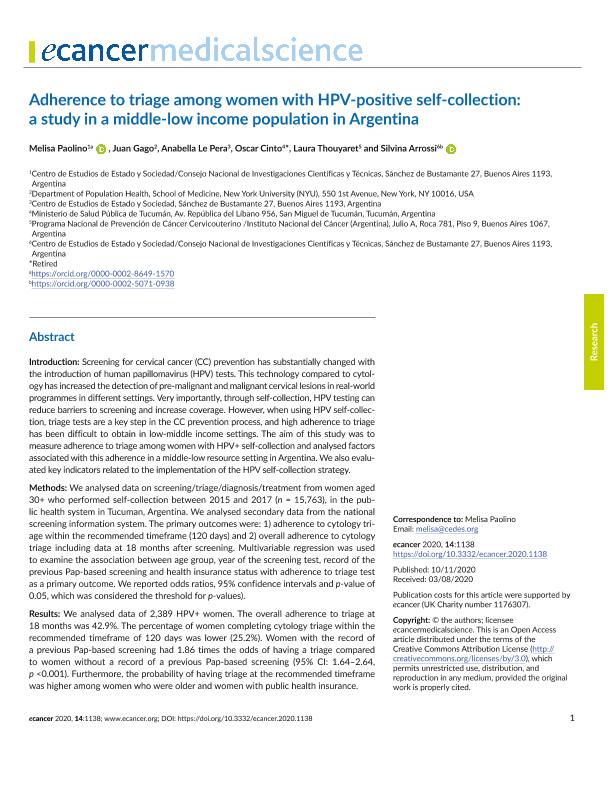Mostrar el registro sencillo del ítem
dc.contributor.author
Paolino, Melisa Delia

dc.contributor.author
Gago, Juan
dc.contributor.author
Le Pera, Anabella Hebe

dc.contributor.author
Cinto, Oscar
dc.contributor.author
Thouyaret, Laura

dc.contributor.author
Arrossi, Silvina

dc.date.available
2022-03-22T03:24:30Z
dc.date.issued
2020-11-10
dc.identifier.citation
Paolino, Melisa Delia; Gago, Juan; Le Pera, Anabella Hebe; Cinto, Oscar; Thouyaret, Laura; et al.; Adherence to triage among women with HPV-positive self-collection: A study in a middle-low income population in Argentina; ecancer Global Foundation; ecancermedicalscience; 14; 10-11-2020; 1-14
dc.identifier.issn
1754-6605
dc.identifier.uri
http://hdl.handle.net/11336/153688
dc.description.abstract
Introduction: Screening for cervical cancer (CC) prevention has substantially changed with the introduction of human papillomavirus (HPV) tests. This technology compared to cytology has increased the detection of pre-malignant and malignant cervical lesions in real-world programmes in different settings. Very importantly, through self-collection, HPV testing can reduce barriers to screening and increase coverage. However, when using HPV self-collection, triage tests are a key step in the CC prevention process, and high adherence to triage has been difficult to obtain in low-middle income settings. The aim of this study was to measure adherence to triage among women with HPV+ self-collection and analysed factors associated with this adherence in a middle-low resource setting in Argentina. We also evaluated key indicators related to the implementation of the HPV self-collection strategy. Methods: We analysed data on screening/triage/diagnosis/treatment from women aged 30+ who performed self-collection between 2015 and 2017 (n = 15,763), in the public health system in Tucuman, Argentina. We analysed secondary data from the national screening information system. The primary outcomes were: 1) adherence to cytology triage within the recommended timeframe (120 days) and 2) overall adherence to cytology triage including data at 18 months after screening. Multivariable regression was used to examine the association between age group, year of the screening test, record of the previous Pap-based screening and health insurance status with adherence to triage test as a primary outcome. We reported odds ratios, 95% confidence intervals and p-value of 0.05, which was considered the threshold for p-values). Results: We analysed data of 2,389 HPV+ women. The overall adherence to triage at 18 months was 42.9%. The percentage of women completing cytology triage within the recommended timeframe of 120 days was lower (25.2%). Women with the record of a previous Pap-based screening had 1.86 times the odds of having a triage compared to women without a record of a previous Pap-based screening (95% CI: 1.64-2.64, p <0.001). Furthermore, the probability of having triage at the recommended timeframe was higher among women who were older and women with public health insurance. Conclusions: Our results showed that adherence to triage in the recommended timeframe was low. In addition, the probability of having triage at the recommended timeframe was higher among women with a record of a previous Pap-based screening, a proxy of the use of health services. Our results showed that adherence to triage in the context of the HPV-self-collection strategy is challenging. The implementation of alternative approaches that might facilitate adherence to triage should be further investigated.
dc.format
application/pdf
dc.language.iso
eng
dc.publisher
ecancer Global Foundation
dc.rights
info:eu-repo/semantics/openAccess
dc.rights.uri
https://creativecommons.org/licenses/by/2.5/ar/
dc.subject
ARGENTINA
dc.subject
CERVICAL CANCER
dc.subject
HUMAN PAPILLOMAVIRUS DNA TEST
dc.subject
LOST TO FOLLOW UP
dc.subject
SELF-SAMPLING
dc.subject.classification
Políticas y Servicios de Salud

dc.subject.classification
Ciencias de la Salud

dc.subject.classification
CIENCIAS MÉDICAS Y DE LA SALUD

dc.title
Adherence to triage among women with HPV-positive self-collection: A study in a middle-low income population in Argentina
dc.type
info:eu-repo/semantics/article
dc.type
info:ar-repo/semantics/artículo
dc.type
info:eu-repo/semantics/publishedVersion
dc.date.updated
2022-03-14T21:08:24Z
dc.identifier.eissn
1754-6605
dc.journal.volume
14
dc.journal.pagination
1-14
dc.journal.pais
Reino Unido

dc.journal.ciudad
Bristol
dc.description.fil
Fil: Paolino, Melisa Delia. Centro de Estudio de Estado y Sociedad; Argentina. Consejo Nacional de Investigaciones Científicas y Técnicas; Argentina
dc.description.fil
Fil: Gago, Juan. University Of New York. School Of Medicine.; Estados Unidos
dc.description.fil
Fil: Le Pera, Anabella Hebe. Centro de Estudio de Estado y Sociedad; Argentina. Consejo Nacional de Investigaciones Científicas y Técnicas; Argentina
dc.description.fil
Fil: Cinto, Oscar. Provincia de Tucuman. Ministerio de Salud; Argentina
dc.description.fil
Fil: Thouyaret, Laura. Ministerio de Salud. Instituto Nacional del Cáncer; Argentina
dc.description.fil
Fil: Arrossi, Silvina. Centro de Estudio de Estado y Sociedad; Argentina. Consejo Nacional de Investigaciones Científicas y Técnicas; Argentina
dc.journal.title
ecancermedicalscience
dc.relation.alternativeid
info:eu-repo/semantics/altIdentifier/url/https://ecancer.org/en/journal/article/1138-adherence-to-triage-among-women-with-hpv-positive-self-collection-a-study-in-a-middle-low-income-population-in-argentina
dc.relation.alternativeid
info:eu-repo/semantics/altIdentifier/doi/http://dx.doi.org/10.3332/ecancer.2020.1138
Archivos asociados
